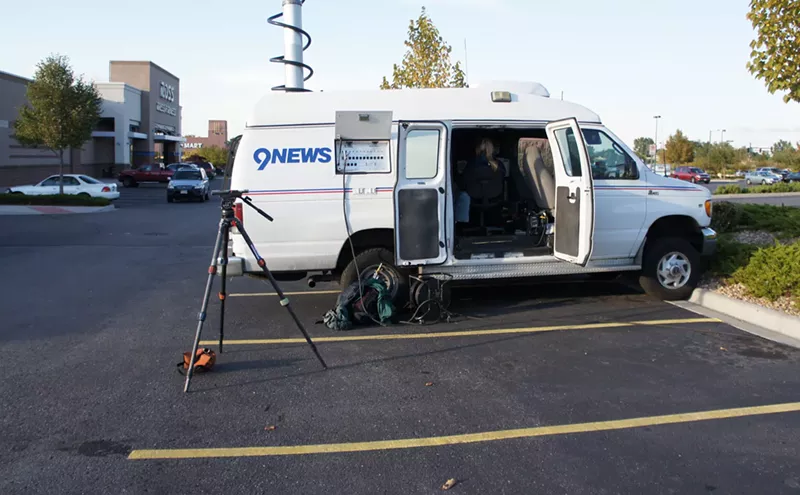They also let in the sound of chickens "going crazy." Lopez followed the crowing and cackling to 4344 Milwaukee Street. No one answered the door of the small white house, so he walked around the side of the building and looked in the back yard.
A dozen roosters were tethered by their ankles to metal spikes in the ground. There was enough leeway in the leashes to let the birds taunt and peck at each other, but not make contact.
A woman came out of the house, and Lopez asked what the birds were for.
No hablo inglés, she replied.
Two young boys came out of the house. They translated for the woman as Lopez asked if the birds were for cockfighting.
She said no, the chickens were for eating.
But Lopez had already noticed that the roosters were taller and thinner than an average bird. Someone had cut the little flaps of skin off of the top of each cock's head and chin -- a standard look for fighting birds -- and also removed half of the spurs from their legs, leaving just short nubs. At cockfights, knives, razors or mini-icepicks are attached to these nubs -- and with artificial spurs, almost every battle is to the death.
Lopez had his young interpreters ask the woman who had doctored the chickens. A man transporting the birds from North Carolina to Mexico had just stopped off on his way, she said.
Lopez called the Denver Police Department, requesting a Spanish-speaking officer and backup to remove the birds.
Police got permission to search the property, which belonged to seventy-year-old Virginia Casillas-Deluicio. Inside a cabinet in the carport, they found a jar that contained a miniature set of boxing gloves -- the sort of training muffs used when the birds spar. Casillas-Deluicio said they belonged to the children. She put the gloves on her fingertips and started jabbing the air. Also inside the jar were Vaseline packets, alcohol swabs and some pink pills. Those were for the kids, too, she said.
The birds belonged to her nephew, Javier, she told the officers.
Casillas-Deluicio followed Lopez into the tool shed, where he spotted a brown suitcase hanging on the wall. Inside the suitcase was a wooden box with a picture of a fighting cock on the top. Inside the box were short knives known as "Mexican slashers," named for their popularity in Mexican cockfighting circles.
Animal control impounded a dozen fighting roosters, three brood hens and four more chickens. Eleven of the roosters' crowns were completely amputated and their spurs trimmed. Two were missing eyes, and another bird's right eye was closed but seemed to be intact. One was missing a bunch of feathers.
"Looking in that back yard," Lopez remembers, "that had been going on for a very long time."
No one knows which came first, the chicken or the egg. But the fight soon followed.
Roosters are alpha males. When another male tries to mess with a rooster's hen, the result is a frenzy of feathers as the birds pounce on each other, using beaks and spurs as weapons. Some scientists believe the spurs evolved for fighting; others suggest the spurs were designed to keep the hens in place during mating.
Like most domesticated chickens, gamecocks descended from the red jungle fowl of India. The birds spread west to Persia and Mesopotamia, the Mediterranean and Greece. Gambling over cockfights wasn't far behind. The Romans introduced cockfighting to Britain, where it was popular in the days of William Shakespeare. Cockfighting moved through Europe and eventually across the ocean to the Colonies. George Washington is said to have been a cockfighter.
Birds that fight today are descendants of champion fighting birds from hundreds of years ago. Because most chicken fights are to the death, only the most aggressive birds survive to breed. "Just like a racehorse, you brood them and breed them and you get good hens out of them," J. Lopez says.
You also get cocks that are killers.
Massachusetts outlawed cockfighting in 1836. Today the blood sport is illegal in all but two states, Louisiana and New Mexico. In Colorado, not only is producing a cockfight a felony, but so is watching a cockfight, possession of a gamecock intended for fighting, and possession of cockfighting paraphernalia.
At cockfighting tournaments in Louisiana and New Mexico, as well as in Mexico, Vietnam and the Philippines, more than a thousand birds may fight to the death in a single weekend tournament as tens of thousands of dollars are won and lost. And the sport's popularity in Mexico spills over into this country. "It's pretty popular with the Mexican nationals," Lopez says. "Every time I've ever had a dealing with them, it's a Mexican national, and they tell you they're taking them to Mexico."
The Mexico excuse, along with the fact that cockfighting is still legal in a couple of states, created a handy loophole for cockfighters caught transporting birds on highways in Colorado and other states that had banned the sport. Law-enforcement authorities couldn't cite drivers who claimed they were simply transporting the birds to states where cockfighting was legal.
In 2001, Senator Wayne Allard, a veterinarian, sponsored legislation to close that loophole. "My concern is that the practice is inhumane to the animals, and in this particular instance, it was also a law-enforcement issue, because they were trying to enforce the cockfighting laws that we had, but when they crossed the state borders, they were exempted," Allard says. "It was very difficult. We had to fight the poultry industry in the South. Eventually, with a lot of help from the Humane Society, we were able to get it passed."
Although the federal law Allard sponsored makes it a federal crime to transport birds across states that don't allow cockfighting, the law doesn't apply in states that still allow cockfights. And while Allard had hoped to make transporting birds for cockfighting a felony, he says that pressure from the poultry industry kept consequences for violating the new law limited to a misdemeanor.
Last year, another Republican veterinarian in the Senate, Nevada's John Ensign, introduced a measure that would have made the interstate commerce of animals for fighting and the interstate commerce of animal-fighting paraphernalia felonies. The bill passed the Senate but is now stalled in a House committee.
In states where cockfighting is banned, the fights continue on a limited, illegal level. John Maulsby, the state veterinarian, was the chief of Colorado's Bureau of Animal Protection for fifteen years. During that time, he saw two or three cockfighting cases a year, he says. But most busts are like the one in Swansea this past spring and another in Weld County last November, when a man was caught with chickens and paraphernalia and charged with animal fighting.
In Adams County, six people have been charged with cockfighting-related crimes over the past dozen years. In November 2003, authorities there seized about $13,000 in cash along with some chickens. In exchange for their guilty pleas, the cockfighting culprits got probation and about half of their money back.
"One of the best things that Colorado ever did was make animal fighting a felony," says Doug Kelley, director of Denver's Division of Animal Control, referring to the law passed more than twenty years ago. "But one of the consequences is that it drove it underground."
Kelley knows chickens: He grew up on a farm outside of Broomfield. He started his law-enforcement career with Denver animal control, then went on to stints with the Westminster and Lakewood police departments. In 2000, he landed back at animal control. His office is at the Denver Municipal Animal Shelter, where a rubber chicken sits on his desk.
Since he's been back in Denver, Kelley estimates that he's seen about five cockfighting busts. Most started with tips from neighbors or postal inspectors, who alerted authorities when they spotted packages with live fowl -- some with doctored crowns and spurs. "They make their delivery, and we walk up knocking and asking the appropriate questions, and we confiscate the birds," he explains. "We've had a few situations where there's been charges. But we really haven't had any actual fights that we've been part of."
A bust near North High School in the late '90s yielded fifteen fighting birds. A few years ago, Kelley's office got a tip on an upcoming cockfight in a garage in northwest Denver -- but by the time animal-control officers arrived, the promoters had closed up shop. Another time they found a fighting bird tethered to a tree and confiscated it. No one ever claimed the cock.
"It's difficult to prove cockfighting as a felony," Kelley says, pointing out that the prosecutor has to show intent to actually fight the birds. "But on this case [in Swansea], from the beginning, everything just came together. It's rock-solid, short of seeing the actual fight."
Ha Manh Do says he didn't know that it was illegal to keep fighting cocks in Lakewood.
Do, a native of Vietnam, has been in the United States for 26 years -- sixteen of those in Colorado. He remembers attending a cockfight when he was a kid in Vietnam, but he didn't enjoy it much. In those days, cockfighting was more natural, "like boxing," he says, with chickens fighting for hours until one was dead or could no longer do battle. It wasn't until about five years ago that the Vietnamese started cutting off the chickens' spurs and attaching knives, Do adds.
In May 2005, a Jefferson County zoning official inspected the chicken coops on Do's property. Three Mexican nationals and four men from Vietnam had been renting space in his coops and storing chickens there. Do had allowed them to raise the birds but says he prohibited any fighting on the property and made the men sign contracts.
Unlike the Mexicans, the Vietnamese men were more interested in raising and selling the chickens than in fighting them, Do says. "We're not experts in cockfighting because we don't know how to put the knives on the birds or to use the injections or to train. We just know how to take care of them and raise them to look good," he explains. "It's a hobby. We do this to pass time so we don't get into trouble doing something else."
Between Lakewood police officers, officials with Jeffco animal control and zoning, and representatives of the state vet's office, Do estimates that close to thirty government employees spent an entire day at his place, confiscating 141 fighting cocks, plus hens and chicks.
In the coop that Do had rented to Juan Cisneros, the authorities found a bottle of "rooster booster," several double-edged razors, tethers and four training muffs. Do gave them a contact number for Cisneros. A Lakewood officer reached a man who admitted to being a former tenant of Do's but said he had moved his birds two years ago. Then the call got cut off.
The next day, Cisneros called the cop back and said that he knew where they could find Do's current tenants, one named "Emilio" and the other called "George." He said that both Emilio and George fought their roosters in New Mexico. Cisneros himself denied fighting his birds, but he admitted that he'd attended a fight at a ranch near Limon.
Cisneros already had a warrant out for failure to appear on a driving-under-restraint charge in Denver, and another warrant out in Lakewood. A third warrant was issued for Cisneros on charges of animal fighting and conspiracy to commit animal fighting.
Inside Do's house, officers found a cockfighting magazine that Do says one of the Mexican guys bought for him at a fight. He was charged with two felonies -- animal fighting and conspiracy to commit animal fighting. "I couldn't believe it's illegal to raise chickens," he recalls. "To fight chickens being illegal, I understand. That's why I have no fight in my contract. I don't like to fight."
Facing four and a half years on the felony charges, Do pled guilty to cruelty to animals, a misdemeanor. He was ordered to pay a $500 fine, perform 24 hours of community service and comply with Lakewood zoning rules. He also received ninety days' probation. The four Vietnamese men who rented coop space from Do received similar deals.
Police are still looking for Cisneros, as well as the other Mexican men involved.
The fighting roosters found on Do's property were euthanized. Some breeding hens and chicks were salvaged.
Colorado's cockfighting fans can get their fix at the Tommy Club, conveniently located between Lovington and Hobbs in New Mexico. The Bible family purchased the fighting pit last year and wrapped up their first season in August.
"Dad's fought chickens all of his life," says Tammy Bible. "Different people come in. We have entries. It's fun. It's a family sport. It's not just for men; it's for women and kids. One girl had her quinceañera here; another had a college fundraiser." Kids as young as three and four come to watch.
Bible is a third-generation cockfighter who's been raising chickens for 38 years, since she was three. She grew up in Texas and traveled to New Mexico to fight her chickens after Texas made the sport illegal, she says. Then her family moved to the state for good.
The Tommy Club has seating for 500 people, and there's no limit on bets. The kitchen serves food -- but no chicken. The bouts are timed for fifteen minutes, and if one bird is killed or both stop fighting, then the match is over. "These birds get treated better than most human kids get treated," Bible says. "They are fed perfect, they are conditioned perfect. They are babied. They are expensive. You can spend $150 a month just on feed for these roosters."
The weapon of choice at the Tommy Club is the "gaff," a mini-icepick that measures an inch or longer. But depending on the derby being advertised, short razors are also used. "Everybody thinks it's cruel, but it's not," Bible insists. "It's not as gross and cruel as people think it is. And when these birds get cut, we sew 'em up. A lot of people think we just throw them away, but we don't."
One regular at the club, Jack Cairnes, is a former state representative from Washington. A third-generation cockfighter himself, Cairnes would take his birds to fights in other states before Washington made it a crime simply to own fighting birds. After Allard's federal legislation passed, Cairnes moved to New Mexico.
"Just the sheer joy of raising chickens and having animals on your place is a joy I wasn't willing to give up," he says. "Fighting is such a tiny part of fighting chickens. Raising and being with them and seeing the thrill of your efforts makes it worth it. We spend 99 percent of our time making sure they don't fight, and then we get together every once in a while and see who raised them the best."
Like Bible, Cairnes says that fighting roosters are treated much better than the chickens that are raised to be butchered. While a chicken that winds up in a supermarket is confined to a dark, tiny cage, fighting roosters live outside in the sunshine. And unlike birds that are butchered, he points out, fighting roosters at least get the chance to fight for their lives, and then wind up as brood cocks if they survive. One of Cairnes's roosters lived to be seventeen.
Cairnes compares cockfighting to football and says the fans are similar, too. "You have people from all walks of life," he says. "That's one of the great things about having chickens. You meet people who are blue-collar construction workers and former legislators. You have doctors and lawyers and businesspeople."
But because cockfighting is a blood sport like hunting and fishing, the animal-rights movement has come after them unfairly, he insists. "It's not a specific type of person who fights chickens," he says. "It's just people who love chickens. It makes no sense to me that anyone would object to me raising a chicken and taking good care of it for two years and then fighting it. Why would someone care? It just doesn't make sense."
Organizations like In Defense of Animals and the Humane Society of the United States are full of people who care. People like Eric Sakach, director of the West Coast regional office, who's fought cockfighting for close to thirty years, testifying in cases across the country, educating law-enforcement agencies and even going undercover.
And the anti-cockfighting cause has made headway. In Arizona, for example, voters pushed through an initiative that made it a felony, and most of that state's cockfighters moved to New Mexico or California, where the penalties are not as harsh. In 2002, when cockfighting became a felony in Oklahoma, many of the sport's fans there also left the state.
But even in New Mexico, several counties and municipalities have banned cockfighting. And in Louisiana, the only other state where it is legal, a bill was introduced in the state senate this year to ban the sport. "I think we're going to see Louisiana fall within two years," Sakach says, adding that he wouldn't be surprised if New Mexico followed suit.
That day can't come too soon for some animal lovers. "Not all cockfighters subscribe to the use of hormones or steroids, but probably half of them out there do," Sakach says. "A lot of cockfighters subscribe to giving various drugs, some homemade, some bought over the counter." The most popular kind of drug contains testosterone, which increases muscle mass and aggression. "In combination with strychnine, or what's called Œformula of nux vomica,' it's poison," he explains, "but in small doses in poultry, it's considered an upper."
Sakach was involved in a case in which authorities confiscated a box filled with knives, blades, syringes and a vial containing a red liquid that turned out to be transmission fluid. "Birds don't have transmissions," he points out. "All we could guess is that the guy was using this stuff to poison his birds, and he had someone in the audience betting against him and he was cheating."
The problems with cockfights aren't limited to animal abuse. Sakach says he's been to hundreds of illegal fights, where gambling is prevalent and the crowd can become violent. "I think one of the more disturbing aspects is the presence of children brought by parents," he adds. "It's raising a generation of future idiots when parents are actually stupid enough to take their children to this, indoctrinating children with the idea that it's okay. You're just creating a future problem."
When the Humane Society battles cockfighting, it's also taking on the United Gamefowl Breeders Association. "In my mind, the UGBA is an organization of cockfighters who raise money, some of it through illegal cockfighting, and then use that money through lawyers and lobbyists to defend this largely illegal blood sport," says John Goodwin, deputy manager of animal-fighting issues for the Humane Society.
But Larry Mathews, one of the UGBA's founding members and its first president back in 1975, disputes that. "We do not advocate nor promote, nor are we involved in any illegal cockfighting activity," he says of the 15,000-member organization. Mathews acknowledges that the UGBA did lobby against Allard's law, but that was because the group believed it would adversely affect tourism, since people couldn't travel from state to state with their chickens.
"Our purpose is to cooperate with universities and veterinarian services for the health and marketing methods and continuation of the species of game fowl, " Mathews says. And game fowl aren't just raised for fighting, he points out. Their feathers are used for fly fishing, and without gamecocks, there'd be no Cornish game hens in the supermarket.
"I'm not involved in promoting cockfighting, I'm not involved in any aspect of it, I'm not qualified to speak about it," Mathews insists. "You can't stop them from fighting, and what happens in a cockfight is two owners let them loose to fight. They don't raise them to fight." In fact, he adds, it's the Humane Society that is cruel, since that organization often euthanizes the birds.
"There's no question that's more humane than allowing the birds to fight with razors on and be hacked to death," Sakach counters. "I think we have to remember who caused this problem in the first place."
While the officers confiscated the birds, a crowd of people gathered outside of Virginia Casillas-Deluicio's house. The elderly woman said something in Spanish to a younger woman.
"Why are you doing this?" the young woman repeated to J. Lopez, the animal-control investigator who'd made the bust. "You're Mexican, too."
"It's against the law," Lopez told her. "It doesn't have anything to do with being Mexican or not."
Casillas-Deluicio's nephew, thirty-year-old Francisco Javier Reyes-Garcia, finally showed up. He told the officers that he didn't know who owned the knives and training gloves, and insisted that the chickens were already doctored when he bought them in North Carolina. He said he was just passing through town on his way to Mexico and that the chickens were a gift for his mother in Zacatecas, because they were a better quality than the chickens back home.
But by the time his aunt was busted, he'd already been in Denver for about a month, he says. (A neighbor says she'd heard the crowing for years.) And now he wants to stay here, because his seventeen-year-old girlfriend is pregnant. Reyes-Garcia is in the country illegally, though, and Denver police notified Immigration and Customs Enforcement of his arrest. ICE confirms that he is awaiting deportation while out on a $3,500 bond; he has a date in immigration court scheduled for January.
First, though, both he and his aunt face charges of animal fighting and aggravated cruelty to animals, crimes that carry up to four and a half years in prison. They were in court on September 7 for an arraignment, which was postponed until October 6 because of a change in attorneys.
Rather than pay the $7,000 it would cost to keep the chickens housed and fed while criminal charges were pending, Reyes-Garcia agreed to let the surviving hens be sent to an animal sanctuary on a farm outside of Brighton. The roosters were euthanized.











